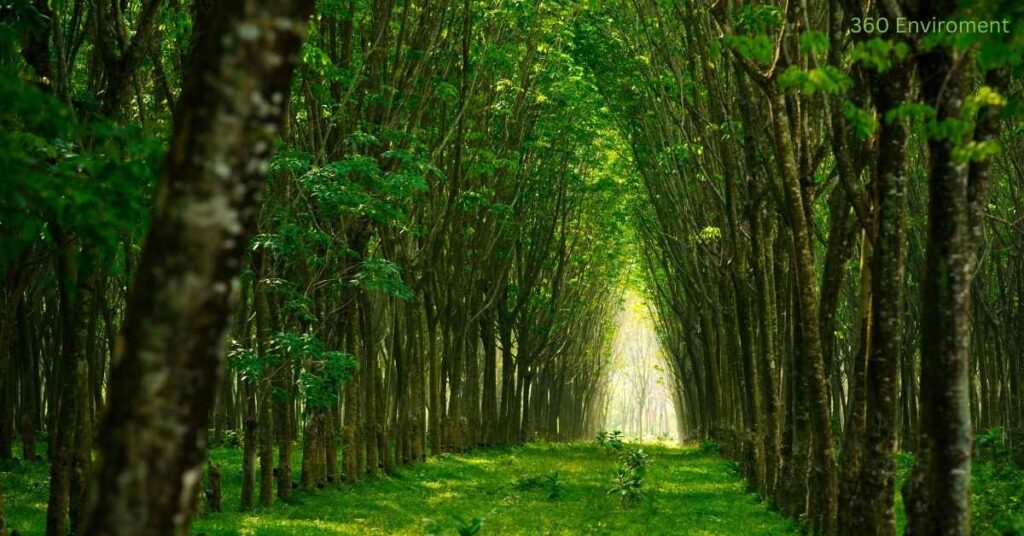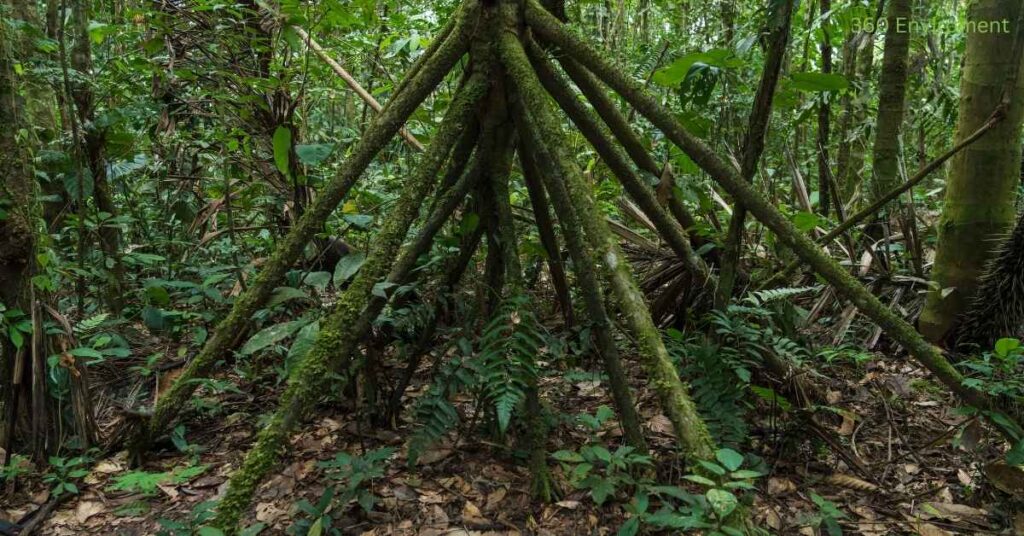In the intricate tapestry of nature, certain trees stand out not only for their towering heights or vast canopies but for their remarkable ability to grow in a way that their branches vine to the ground. This unique adaptation allows these trees to spread outward, creating new roots from their branches, which can form additional trunks. These species often develop into expansive, multi-trunked organisms that contribute significantly to the ecological landscape. Their fascinating growth patterns make them ecologically important, as they provide shelter, food, and stabilize the surrounding environment.
This article explores several species of tree where brances vine to the ground, including the banyan tree, strangler figs, and others like the rubber tree and walking palm. We will delve into their ecological significance, the environments they thrive in, and how these extraordinary trees promote biodiversity and sustainability.
1. Banyan Tree (Ficus benghalensis)
As the most famous example of a tree where branches vine to the ground, the banyan tree (Ficus benghalensis) is a member of the fig family and is native to the Indian subcontinent. Its defining characteristic is the ability to send down aerial roots from its sprawling branches, which, upon reaching the soil, form new trunks. This process allows the banyan tree to cover vast areas, making it appear as though an entire grove of trees exists, when in reality, it’s a single organism.

1.1 Ecological Role
The banyan tree provides an incredible habitat for numerous species. Its expansive canopy creates shade, helping to regulate temperature and moisture levels beneath it. Animals such as birds, bats, insects, and small mammals thrive in the banyan tree’s unique ecosystem. The figs produced by the banyan tree are a vital food source for these animals, aiding in the dispersal of seeds and supporting the regeneration of forests.
1.2 Cultural Importance
In addition to its ecological significance, the banyan tree has deep cultural and spiritual roots in South Asia. It is often revered as a sacred tree, symbolizing immortality and fertility. Temples are frequently built beneath its canopy, and the tree is associated with gods in various religious traditions, particularly Hinduism and Buddhism.
2. Strangler Fig (Ficus aurea)
The strangler fig is another fascinating member of the fig family, native to tropical and subtropical regions of the Americas, including the Caribbean and parts of the southern United States. The growth pattern of this tree is both unique and somewhat parasitic. It begins its life as an epiphyte, germinating in the crevice of a host tree. As it grows, it sends down aerial roots that eventually reach the ground. Over time, these roots wrap around the host tree, often “strangling” and killing it, thus the name “strangler fig.”

2.1 Growth and Vining Branches
Like the banyan tree, the strangler fig’s branches send out aerial roots that eventually vine to the ground and become new trunks. As the tree matures, these additional trunks form a lattice-like structure around the host tree, which can reach impressive heights. Once the host tree decays and dies, the strangler fig can stand on its own as a self-supporting tree, often with a hollow core where the host tree once stood.
2.2 Ecological Role
The strangler fig plays a critical role in tropical ecosystems. Its figs are a keystone food source for a wide range of animals, including monkeys, birds, and bats. The tree also provides a complex habitat, with its dense root system offering shelter and nesting sites for numerous species.
3. Rubber Tree (Hevea brasiliensis)
The rubber tree, native to the Amazon rainforest, is another tree that has adapted to send out aerial roots. While not as prolific in vining branches as the banyan or strangler fig, the rubber tree can produce prop roots from its branches, especially when growing in swampy or flooded environments. This adaptation helps stabilize the tree in unstable soils and ensures it can access water and nutrients more effectively.

3.1 Ecological Role
In its native environment, the rubber tree provides habitat for various species of insects and birds. The latex it produces is an essential resource for both humans and animals. In tropical regions, rubber trees play a significant role in the economy due to their latex, which is harvested to make natural rubber.
3.2 Sustainability
Rubber trees, when cultivated sustainably, can contribute to reforestation efforts and carbon sequestration. However, large-scale rubber plantations can lead to deforestation if not managed properly. Therefore, sustainable rubber farming practices are essential to maintaining the balance between economic benefits and environmental conservation.
4. Walking Palm (Socratea exorrhiza)
The walking palm, native to tropical rainforests in Central and South America, exhibits an unusual form of movement. While not a traditional tree where branches vine to the ground, the walking palm’s stilt roots enable it to “walk” toward sunlight. The tree grows tall, slender trunks supported by a series of aerial roots, which can adjust their positions in response to environmental conditions.

4.1 Growth and Movement
The walking palm’s roots grow from the trunk above ground, forming stilt-like supports. These roots can move very slowly over time as the tree shifts in response to sunlight or other environmental factors. While it does not “walk” in the traditional sense, the walking palm’s ability to grow new roots in the direction of sunlight gives it the appearance of movement.
4.2 Ecological Importance
The walking palm contributes to the diversity of tropical forests by providing habitat and food for various species. Its roots create shelter for small animals and insects, while its tall trunk allows it to compete for sunlight in densely vegetated areas. The tree’s unique root system also helps stabilize the soil in areas prone to erosion.
5. Red Mangrove (Rhizophora mangle)
The red mangrove, native to tropical and subtropical coastal regions, is a vital species in the fight against coastal erosion and climate change. Red mangroves are characterized by their prop roots, which extend from their branches and help anchor the tree in muddy, saline environments. These aerial roots vine down to the ground, creating a tangled, stabilizing structure that supports not only the tree but the entire coastal ecosystem.

5.1 Ecological Role
Red mangroves form dense coastal forests that provide critical habitat for marine life, including fish, crabs, and shrimp. The prop roots also create a nursery for juvenile fish, helping sustain local fisheries. Additionally, mangroves protect coastlines from erosion and act as a buffer against storm surges, reducing the impact of hurricanes and other extreme weather events.
5.2 Carbon Sequestration
Mangrove forests are some of the most effective ecosystems for carbon sequestration. The thick, peaty soil beneath mangroves can store large amounts of carbon, preventing it from being released into the atmosphere. This makes mangrove trees a vital component in mitigating climate change.
6. Balsa Tree (Ochroma pyramidale)
The balsa tree, native to the rainforests of Central and South America, is known for its lightweight wood, often used in the construction of model aircraft, boats, and even some full-scale airplanes. While the balsa tree does not have the extensive vining roots of the banyan or strangler fig, it does exhibit a fascinating root system that helps it stabilize in nutrient-poor, swampy environments.
6.1 Growth Characteristics
Balsa trees grow quickly, often reaching maturity in just a few years. They have shallow root systems, which help them thrive in the swampy conditions of tropical rainforests. While they do not send out aerial roots, their rapid growth and ability to thrive in challenging environments make them an important species in forest regeneration projects.
6.2 Ecological Role
In tropical rainforests, balsa trees provide a source of food and shelter for a variety of wildlife. Their rapid growth helps regenerate forests that have been degraded by logging or other human activities. Additionally, the balsa tree’s lightweight wood makes it a sustainable resource when harvested responsibly.
Conclusion: The Importance of Tree where brances vine to the ground
The trees discussed in this article—from the banyan tree to the red mangrove—demonstrate the incredible diversity and adaptability of species that use aerial roots and vining branches to thrive in their environments. These trees not only create unique ecosystems but also provide critical ecological services, including carbon sequestration, habitat creation, and soil stabilization.
Understanding and protecting these remarkable trees is essential for maintaining biodiversity and promoting sustainability. As environmental challenges such as climate change and deforestation continue to threaten ecosystems, the tree where brances vine to the ground offer a powerful reminder of nature’s ability to adapt and survive in the face of adversity.
Read More: The Complete Guide to Hydroponics and Hydroponic Systems

